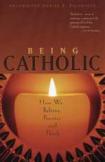Pass It On
I like this book. And this troubles me.
Being Catholic: How We Believe, Practice and Think was originally a series of articles that Archbishop Daniel Pilarczyk wrote for the Cincinnati archdiocesan paper, The Catholic Telegraph. Pilarczyk has revised the articles into a book for a wider market. Let me first share with you the author’s intention and then offer a synopsis of his work.
The archbishop’s reason for writing is to give some idea of the richness, complexity and vitality that are involved in being Catholic. The book, intended for both Catholic and non-Catholic audiences, is not a work of professional theology; rather it is a pastoral exhortation. Pilarczyk calls it an act of witnessing, a testimony to the generosity of God that Catholics experience in accepting and living out the gift of faith.
Each of the book’s three parts has roughly a dozen article-length chapters. The writing style is clear, engaging andin many wayspersuasive. Given that the chapters originated as separate articles, the book is blessedly free from repetition. Each chapter includes several questions for discussion and reflection; most chapters also end with references to the Catechism of the Catholic Church. Thus the book could be used for parish discussion groups.
What is being said when the author talks about the meaning of believing, practicing and thinking Catholic? Under Believing Catholic the author sees faith as both accepting creedal truths and living what (and with Whom) these truths reveal. To grow in faith is to engage ever more deeply with both. The stories of creation and of Jesus’ life, death and resurrection supply the creedal truths of Catholic faith. Sin (the wrench in the works) socially and personally impedes our growth, while gracefreely given by God through Christ and freely accepted by us through grace itselflets us be people of hope. Similarly, the chapters on the church as community and mission spell out a vision that encourages readers to see themselves as co-conspirators with the triune God in making the world more just and humane. Pilarczyk sees the Eucharist as the heart of the Church. He writes, Everything the Church is and does is somehow directed toward the Eucharist...and has its source in the Eucharist.
The second part, Practicing Catholic, is also specific in its directives. Attendance at Mass, reception of the sacraments, prayer, visiting the Blessed Sacrament, penance and self-control, Mary and the saints, marrying and raising children in the faith, being active in the parish, being willing to be different and dying Catholiceach is presented as a loving challenge. The practices are not given equal weight; they are, however, urged upon the reader as opportunities to mature in holiness. Catholic practices put us in touch with the incarnate Jesus, allowing us to respond generously to whatever God asks of us. In times of pain or confusion, they can be the glue that holds us together. The archbishop makes a convincing case for the value of good habitslearned early and appropriated fullyin building a life of faith.
In Thinking Catholic, the final section of the book, Pilarczyk writes: Thinking Catholic is a mindset, an attitude of the heart, a bundle of insights and presumptions and priorities and directions that are derived from faith and which, in turn, strengthen and vitalize the practice of faith. The chapters often reflect an attitude of both-and. The world is both a wonderful creation of God where he is the host and we are the guests and a place of suffering where God’s presence is not always apparent and we often are ungrateful guests. He continues the inclusive imagery when saying, The church is old and new, comforting and frustrating, demanding and reassuring. The Lord calls us to embrace it all. Thinking Catholic means being in love with the Church.
Near the end of the book, Pilarczyk counsels readers to reflect and pray, if they wish to mature in their faith. Like most of what he says, this advice is salutary.
What troubles me about this book? Why do I find it problematic? Because I share the vision it offers and do not believe that this vision is available today to large portions of the Catholic population, much less people of good will outside the church. The book reminded me of my childhood in the 1940’s and 1950’s, when parents, peers and neighborhood mores inculcated both Catholic faith and culture. That era is gone, but the human need and desire for God is not. Our work as believers is to hand on the faith we received in ways that will reveal its intrinsic beauty and value.
Perhaps if this book were read prayerfully and discussed by a wide range of Catholicspracticing, disaffected, young, old, gay, straight, bishops and barely-churchedand their collective wisdom tapped, we might discover how to renew the faith (and face) of the church. Otherwise, I fear that it will remain for the most part an exercise in nostalgia.
This article also appeared in print, under the headline “Pass It On,” in the June 5, 2006, issue.








